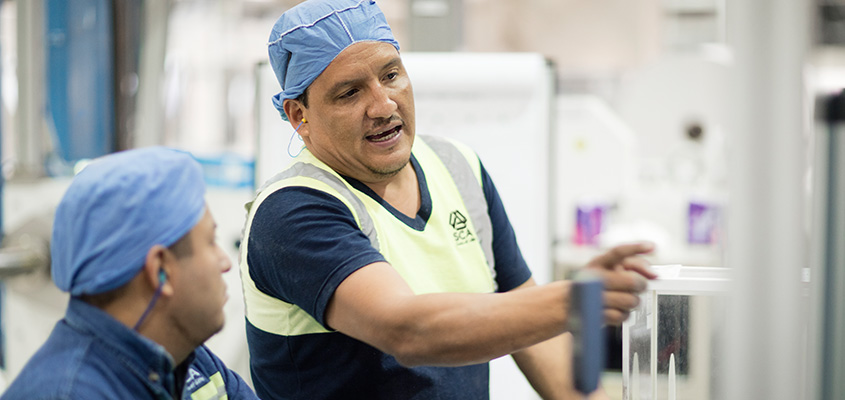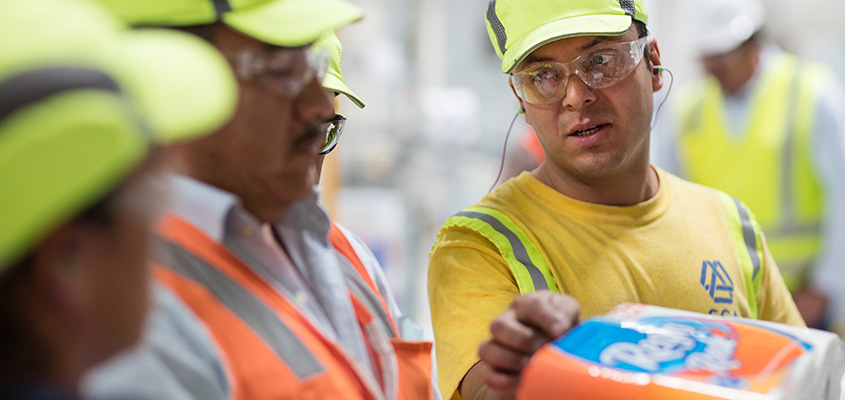Efficiency – a prerequisite for success
Drive efficiency

SCA is dedicated to improving efficiency in the entire value chain. Central to this work is establishing the right structures and streamlining all parts of the business. A lasting positive impact on earnings can be achieved when all areas of SCA cooperate using an integrated and efficient approach. By improving efficiency and maximizing production, minimizing waste and continuously finding ways to reduce material and logistics costs, the company will strengthen its competitiveness, cut costs and improve profit while reducing its environmental impact.
SCA is working to benefit from global economies of scale and expertise to streamline all parts of the business and establish a world-class supply chain. Within SCA, two global units are responsible for sourcing, production, logistics and technology: Global Hygiene Supply Personal Care and Global Hygiene Supply Tissue.
Safety in everything we do
SCA’s aim is zero workplace accidents. Regrettably, a tragic fatal accident occurred at SCA in 2016. SCA works actively with measures to ensure that similar accidents are not repeated.
During 2016, SCA held its second global safety week to raise awareness and improve knowledge about safe working methods for the entire business. SCA workplaces conducted activities around the theme “Friends at work – together we are safer”, to remind employees that “we are safer when we take care of each other and look after each other every day”.
During 2016, the accident frequency rate decreased by 27% and in 2014–2016 it fell by 31%. The target is to reduce the accident frequency rate by 50% between 2014 and 2020.
The target is to halve the accident
frequency rate between 2014 and 2020
World-class supply chain
There are many elements that signify a world-class supply chain; safety, cost efficiency, resource efficiency, quality, flexibility, excellent service level and capital efficiency. It is critical for the business to have an efficient supply chain, with cost-competitive product specifications as well as efficient procurement, production and logistics to optimize profitability and return on capital employed in all parts of the company. One example of this is in the production of feminine care products in Europe, where asset utilization has increased substantially by speeding up machines and improving machine efficiency. This has enabled SCA to absorb the sales growth in feminine care with existing production lines, pushing forward investments in new lines.
Tissue Roadmap
To further improve efficiency and increase value creation within the Tissue business area, a “Tissue Roadmap” was launched during 2016. This consists of a ten-year plan to optimize the supply chain, increase cost and capital efficiency, secure capacity for future growth and enable faster production adaption in conjunction with innovations and product upgrades. It balances structural and organic efficiency opportunities in the supply chain with capacity expansion in selected markets. In Europe, measures were implemented during 2016 to further enhance efficiency and strengthen competitiveness. A tissue production plant in Sant Joan de Mediona, Spain, was closed and restructuring measures were carried out at production facilities in Hondouville and Saint-Etienne-du-Rouvray in France.
Smarter utilization of materials
Cost of goods sold (COGS) is a major part of net sales. SCA drives efficiency improvement and cost savings in all areas to reduce COGS as a percentage of net sales. Raw material is the major part of COGS. Significant savings have been reached through smarter utilization of materials, reducing waste in production, material optimization and the use of new materials at a lower cost. These actions also resulted in reduced environmental impact through improved resource efficiency.
Global energy-saving program reduces climate impact
Energy is a prioritized area for continuous improvement at SCA. In 2003, the Energy Savings and Efficiency (ESAVE) program was started, which is a structured program to reduce energy consumption by production units. ESAVE has contributed to improved efficiency, energy savings, cost savings and reduced climate impact. In 2016, 101 ESAVE projects were implemented, resulting in a 0.9% reduction in energy used per ton of product produced.
Speed to market with innovations
Establishing more efficient production and processes enables a higher speed to market of innovations and faster customer adaptations. This in turn improves customer service and satisfaction. For SCA, this is about developing the right technologies in close cooperation with suppliers, rebuilding machines and launching innovations at the right time. The key to success is enabling both faster innovation launches and improved performance. An increased cooperation along the full value chain is contributing to value creation in both production and sales.
Successful efficiency programs in SCA’s forest products business
SCA’s forest products business is active in an international market. Both customers and competitors are present all around the world. Competitiveness is impacted by factors such as product quality, sustainability and service level, but also by external factors such as access to raw materials and the cost of raw materials, wage levels and other local costs, the distance to customers and not least currency.
When competitiveness and profitability are strongly impacted by external factors, it becomes even more important to focus on the competitive factors that a company can influence. One such factor, perhaps the most important, is production efficiency.
The forest products business has a long tradition of working with developing and improving production efficiency. Even if efficiency work is a continuous process, that is never complete, you can make substantial advances by focusing on the different components in this work.
Since the turn of the millennium, forest products business has run four focused general earnings improvement programs. A few of these focused on reducing direct or indirect costs. Others have had a broader impact and also focused on increasing revenues. A common feature for these programs was clear targets broken down to the different production units. The programs have tried to mobilize many employees both in conceptual work and implementation and there has been a careful follow up.
This successful working method is now continuing in the systematic and long-term work to improve profitability.

Back to SCA's strategy
